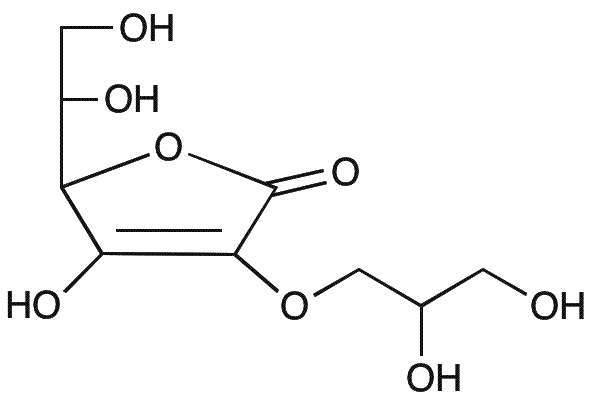Glyceryl ascorbate is widely utilized in research focused on
- Cosmetics and Skincare: This compound is often incorporated into skincare products due to its antioxidant properties, helping to protect the skin from oxidative stress and improve overall skin health.
- Food Preservation: Glyceryl ascorbate acts as a natural preservative, enhancing the shelf life of food products by preventing oxidation, which is particularly beneficial in the food industry.
- Pharmaceuticals: In the pharmaceutical sector, it serves as a stabilizing agent for formulations, ensuring the efficacy and longevity of active ingredients in various medications.
- Dietary Supplements: It is commonly used in dietary supplements as a source of vitamin C, providing health benefits such as immune support and collagen synthesis.
- Agricultural Applications: Glyceryl ascorbate can be utilized in agriculture as a plant growth enhancer, promoting better growth and resilience in crops through its antioxidant effects.
General Information
Properties
Safety and Regulations
Applications
Glyceryl ascorbate is widely utilized in research focused on
- Cosmetics and Skincare: This compound is often incorporated into skincare products due to its antioxidant properties, helping to protect the skin from oxidative stress and improve overall skin health.
- Food Preservation: Glyceryl ascorbate acts as a natural preservative, enhancing the shelf life of food products by preventing oxidation, which is particularly beneficial in the food industry.
- Pharmaceuticals: In the pharmaceutical sector, it serves as a stabilizing agent for formulations, ensuring the efficacy and longevity of active ingredients in various medications.
- Dietary Supplements: It is commonly used in dietary supplements as a source of vitamin C, providing health benefits such as immune support and collagen synthesis.
- Agricultural Applications: Glyceryl ascorbate can be utilized in agriculture as a plant growth enhancer, promoting better growth and resilience in crops through its antioxidant effects.
Documents
Safety Data Sheets (SDS)
The SDS provides comprehensive safety information on handling, storage, and disposal of the product.
Product Specification (PS)
The PS provides a comprehensive breakdown of the product’s properties, including chemical composition, physical state, purity, and storage requirements. It also details acceptable quality ranges and the product's intended applications.
Certificates of Analysis (COA)
Search for Certificates of Analysis (COA) by entering the products Lot Number. Lot and Batch Numbers can be found on a product’s label following the words ‘Lot’ or ‘Batch’.
*Catalog Number
*Lot Number
Certificates Of Origin (COO)
This COO confirms the country where the product was manufactured, and also details the materials and components used in it and whether it is derived from natural, synthetic, or other specific sources. This certificate may be required for customs, trade, and regulatory compliance.
*Catalog Number
*Lot Number
Safety Data Sheets (SDS)
The SDS provides comprehensive safety information on handling, storage, and disposal of the product.
DownloadProduct Specification (PS)
The PS provides a comprehensive breakdown of the product’s properties, including chemical composition, physical state, purity, and storage requirements. It also details acceptable quality ranges and the product's intended applications.
DownloadCertificates of Analysis (COA)
Search for Certificates of Analysis (COA) by entering the products Lot Number. Lot and Batch Numbers can be found on a product’s label following the words ‘Lot’ or ‘Batch’.
*Catalog Number
*Lot Number
Certificates Of Origin (COO)
This COO confirms the country where the product was manufactured, and also details the materials and components used in it and whether it is derived from natural, synthetic, or other specific sources. This certificate may be required for customs, trade, and regulatory compliance.


